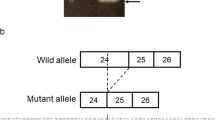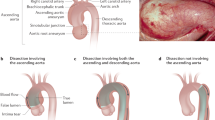Abstract
Congenital contractural arachnodactyly (CCA) is an autosomal dominant disorder that is phenotypically similar to Marfan syndrome (MFS) and characterized by arachnodactyly, dolichostenomelia, scoliosis, multiple congenital contractures and abnormalities of the external ears1. In contrast to MFS, CCA does not affect the aorta or the eyes. Two closely related genes, FBN1 located on chromosome 15q15–21.3 and FBN2 located at 5q23–31, encode large fibrillin proteins found in extracellular matrix structures called microfibrils2–4. The MFS is caused by mutations in FBN1, while CCA has been genetically linked to FBN2 (refs 2, 5, 6). We now describe a pair of FBN2 missense mutations in two CCA patients that cause substitution of distinct cysteine residues in separate epidermal growth-factor-like (EGF) repeats. Our study provides final proof of the association between FBN2 mutations and CCA pathology, thus establishing the role of the fibrillin-2 in extracellular matrix physiology and pathology.
Similar content being viewed by others
References
Beals, R.K. & Hetcht, F. Congenital contractural arachnodactyly: A heritable disorder of connective tissue. J. Bone Jt. Surg. 53A, 987–993 (1971).
Lee, B. et al. Linkage of Marfan syndrome and a phenotypically related disorder to two different fibrillin genes. Nature 352, 330–334 (1991).
Corson, G.M., Chalberg, S.C., Dietz, H.C., Charbonneau, N.L. & Sakai, L.Y. Fibrillin binds calcium and is coded by cDNAs that reveal a multidomain structure and alternatively spliced exons at the 5′ end. Genomics 17, 476–484 (1993).
Zhang, H. et al. Structure and expression of fibrillin-2, a novel microfibrillar component preferentially located in elastic matrices. J. Cell Biol. 124, 855–863 (1994).
Dietz, H.C. et al. Marfan syndrome caused by a recurrent de novomissense mutation in the fibrillin gene. Nature 352, 337–339. (1991).
Tsipouras, R et al. Genetic linkage of the Marfan syndrome, ectopia lentis, and congenital contractural arachnodactyly to the fibrillin genes on chromosomes 15 and 5. New Engl. J. Mod. 326, 905–909 (1992).
Davis, E.C. Immunolocalization of microfibril and microfibril-associated proteins in the subendothelial matrix of the developing mouse aorta. J. Cell Sci. 107, 727–736 (1994).
Zhang, H., Hu, W. & Ramirez, F. Developmental expression of fibrillin genes suggests heterogeneity of extracellular microfibrils. J. Cell Biol. 129, 1165–1176 (1995).
Tynan, K. et al. Mutation screening of complete fibrillin-1 coding sequence: report of five new mutations, including two in 8-cysteine domains. Hum. molec. Genet. 2, 1813–1821 (1993).
Dietz, H.C., Saraiva, J.M., Pyeritz, R.E., Cutting, G.R. & Francomano, C.A. Clustering of fibrillin missense mutations in Marfan syndrome patients at cysteine residues in EGF-like domians. Hum. Mutat. 1, 366–374 (1993).
Nijbroek, G. et al. Fifteen novel FBN1 mutations causing Marfan syndrome detected by heteroduplex analysis of genomic amplicons. Am. J. hum. Genet. 57, 8–21 (1995).
Eldadah, Z.A., Brenn, T., Furthmayr, H. & Dietz, H.C. Expression of a mutant human fibrillin allele upon a normal human or murine genetic background recapitulates a Marfan cellular phenotype. J. clin. Invest. 95, 874–880 (1995).
Sakai, L.Y., Keene, D.R. & Engvall, E., A new 350KD glycoprotein, is a component of extracellular microfibrils. J. Cell Biol. 103, 2499–2509 (1986).
Yeh, H. et al. Structure of the human gene encoding the associated microfibrillar protein (MFAP1) and localization to chromosome 15q15-q21. Genomics 23, 443–449 (1994).
Brown-Augsburger, P. et al. Microfibril-associated glycoprotein binds to the carboxyl-terminal domain of tropoelastin and is a substrate for transglutaminase. J. biol. Chem. 269, 28443–28449 (1994).
Milewicz, D.M., Pyeritz, R.E., Crawford, E.S. & Byers, P.H. Marfan syndrome: Defective synthesis, secretion and extracellular matrix formation of fibrillin by cultured dermal fibroblasts. J. clin. Invest. 89, 79–86 (1992).
Aoyama, T., Franke, U., Dietz, H.C. & Furthmayr, H. Quantitative differences in biosynthesis and extracellular deposition of fibrillin in cultured fibroblasts distinguish five groups of Marfan syndrome patients and suggest distinct pathogenetic mechanisms. J. clin. Invest. 94, 130–137 (1994).
Raghunath, M., Kielty, C.M. & Steinmann, B. Truncated profibrillin of a Marfan patient is of apparent similar size as fibrillin: Intracellular retention leads to over-N-glycosylation. J. molec. Biol. 248, 901–909 (1995).
Devereaux, R.B. & Brown, W.T. Genetics of mitral valve prolapse. Prog. med.Genef. 5, 139 (1983).
Lujan, J.E., Carlin, M.E. & Lubs, H.A. A form of X-linked mental retardation with Marfanoid habitus. Am. J. med. Genet. 17, 311–322 (1984).
Shprintzen, R.J. & Goldberg, R.B. A recurrent pattern syndrome of cranio-synnotosis associated with arachnodactyly and abdominal hernias. J. Craniofacial Genet. Devel. Biol. 2, 65–74 (1982).
Sambrook, J., Fritsch, E.F. & Maniatis, T. Molecular cloning: A Laboratory Manual (Cold Spring Harbor Laboratory Press, Plainview, New York,1989).
Chomczynski, P. & Sacchi, N. Single-step method of RNA isolation by acid guanidinium thiocyanate-phenol-chloroform extraction. Analyt. Biochem. 162, 156–159 (1987).
Orita, M., Youichi, S. & Sekiya, S. Rapid and sensitive detection of point mutations and DNA polymorphisms using polymerase chain reaction. Genomics 5, 974–879 (1989).
Biddinger, A.L., Hecht, J. & Milewicz, D.M. Repeat polymorphisms in human fibrillin genes on chromosome 15 (Fib 15) and chromosome 5 (Fib 5). Hum. molec. Genet. 2, 13–23 (1993).
Cooke, R.M. et al. The solution structure of human epidermal growth factor. Nature 327, 339–341 (1987).
Author information
Authors and Affiliations
Rights and permissions
About this article
Cite this article
Putnam, E., Zhang, H., Ramirez, F. et al. Fibrillin–2 (FBN2) mutations result in the Marfan–like disorder, congenital contractural arachnodactyly. Nat Genet 11, 456–458 (1995). https://doi.org/10.1038/ng1295-456
Received:
Accepted:
Issue Date:
DOI: https://doi.org/10.1038/ng1295-456
- Springer Nature America, Inc.
This article is cited by
-
The roles and regulatory mechanisms of TGF-β and BMP signaling in bone and cartilage development, homeostasis and disease
Cell Research (2024)
-
Carrying both COL1A2 and FBN2 gene heterozygous mutations results in a severe skeletal clinical phenotype: an affected family
BMC Medical Genomics (2022)
-
The jam session between muscle stem cells and the extracellular matrix in the tissue microenvironment
npj Regenerative Medicine (2022)
-
Discovery and systematic characterization of risk variants and genes for coronary artery disease in over a million participants
Nature Genetics (2022)
-
Marfan syndrome
Nature Reviews Disease Primers (2021)





